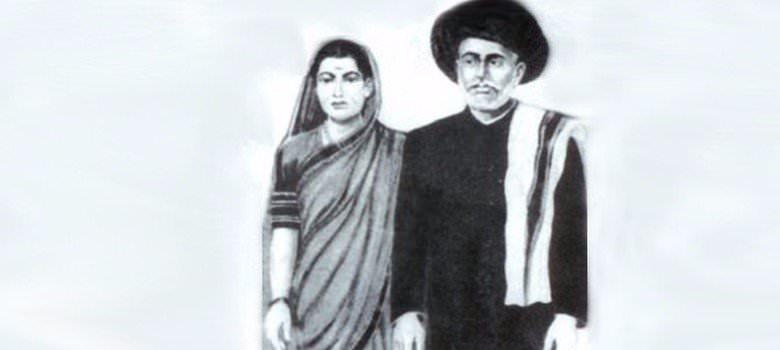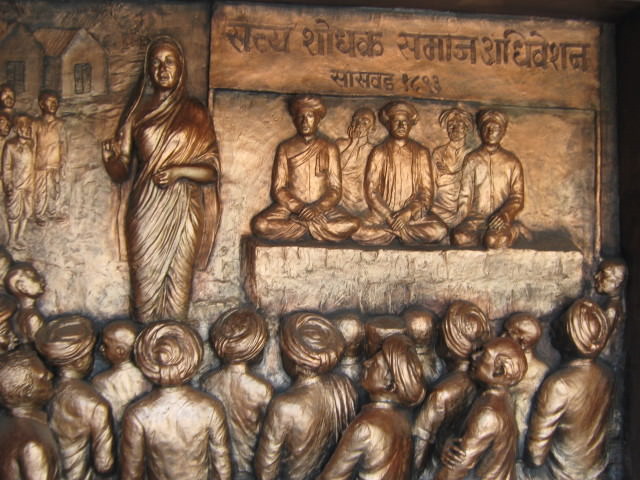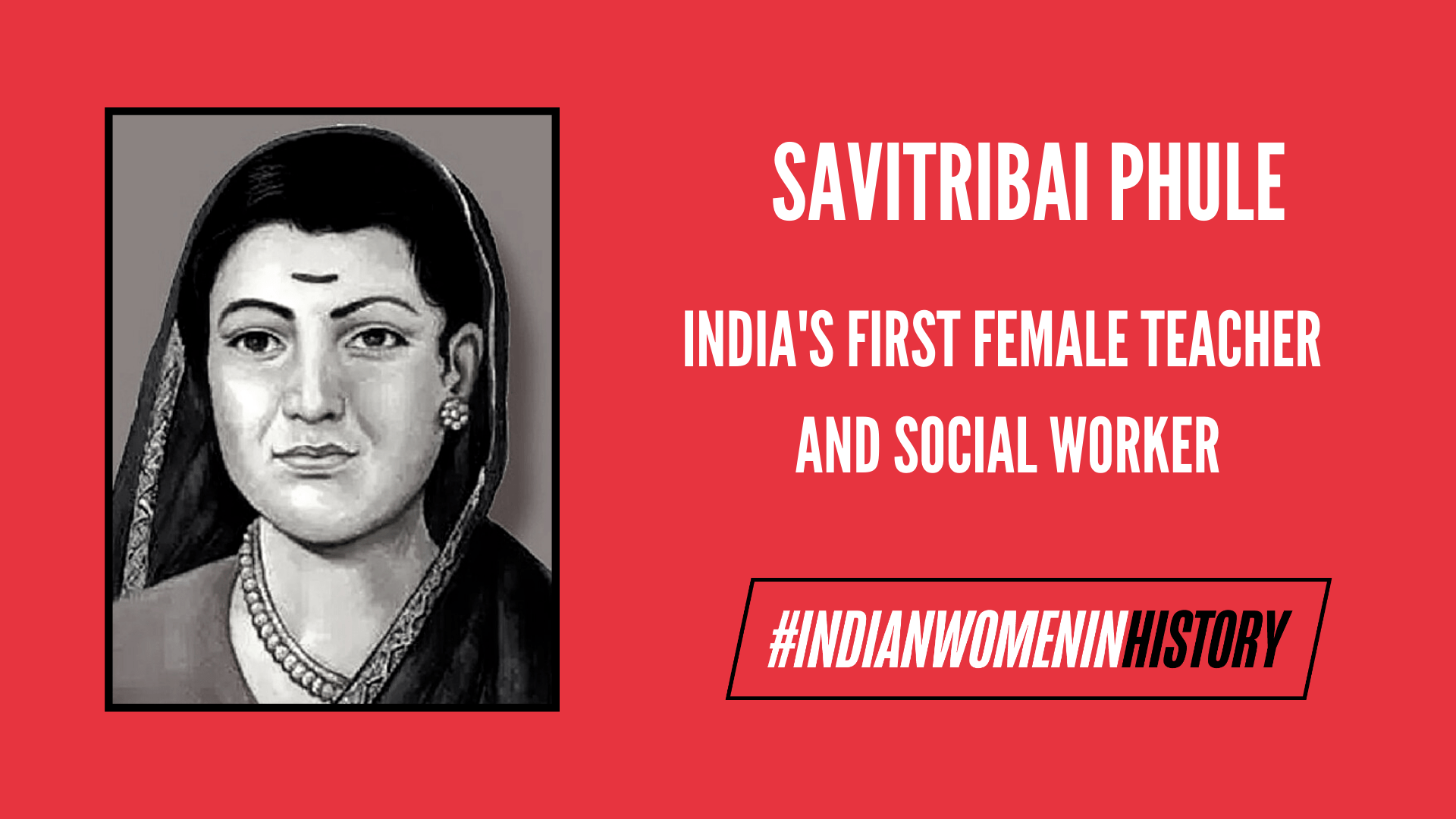Savitribai Phule, the first female teacher of the first women’s school in India is a pioneer figure. She relentlessly fought against the dominant caste system and worked towards the upliftment of the marginalized.
She demanded dignity for all women, for which she, along with her husband Jyotirao Phule worked their entire lives. The principles of humanity, equality, liberty and justice were of utmost importance to her. During a time when women were mere objects, she ignited a spark that led to equality in education – something which was impossible before.
She strongly spoke against the discriminatory boundaries imposed on women, which led to their oppression. Her emphasis on secular education for social emancipation in India is the marker of her significant personality. By getting to know her better, by understanding her struggles and hardships, we will be looking into a life that not only changed the face of education in India, but also enlightened humanity in its real essence.
Early Life and Work
Savitribai Jyotirao Phule was born on January 3, 1831 at Naigaon, about 50 kms from Pune. She was the eldest daughter of mother Lakshmi and father Khandoji Neveshe Patil. In 1840, at the age of 10, she was married to Jyotirao, who was 13 at the time. After marriage Savitribai and Jotiba lived in a Dalit-working class locality in Pune. Jyotirao educated his wife at home and trained her to become a teacher. The responsibility of Savitribai’s further education was taken up by Jyotirao’s friends Sakharam Yeshwant Paranjpe and Keshav Shivram Bhavalkar (Joshi). Savitribai also had taken teacher’s training at Ms. Farar’s institute in Ahmednagar and in the Normal School of Ms. Mitchell in Pune.
Savitribai went on to become India’s first woman teacher and headmistress. It is her struggle and story that marks the beginning of modern Indian women’s public life in India.
The extraordinary couple was engaged in a passionate struggle to build a movement for equality between men and women and a fight against the caste system. They dedicated their lives to spreading education and knowledge. They started the first school in the country for girls and the ‘Native Library’. In 1863, they started a ‘home for the prevention of infanticide’ in their own house, to ensure the safety of pregnant and exploited widows. They also established the Satyashodhak Samaj (Society for Truth Seeking), initiating the practice of marriage without dowry or overt expenses. They were against child marriage and supported widow remarriages. They had no children of their own but adopted a child of a Brahmin widow, educating him and arranging an inter-caste marriage for him.

Savitribai and Jotiba built a revolutionary social education movement for shudra and atishudra women of the country. After starting the school in 1848 and training Savitribai Phule, Jotiba started a school for the Mahars and the Mangs. But within six months, his father threw them out of the house and the school work came to an abrupt halt. Govande came to Pune and took Savitribai with him to Ahmednagar. After she came back, Keshav Shivram Bhavalkar took up the responsibility of educating her. Jyotirao and Savitribai focused on providing girls and boys vocational and practical education, to make them capable of independent thought. They believed that an industrial department should be attached to the schools where children could learn useful trades and crafts and be able to manage their lives comfortably and independently.
They insisted that ‘education should give one the ability to choose between right and wrong and between truth and untruth in life.’ They took special efforts to create spaces where the creativity of boys and girls could bloom. Their success is evident from the fact that young girls loved to study under their guidance, so much so that their parents would complain of the girls’ dedication to studies.
The Person
Students who lived in the hostel run by Jyotirao and Savitribai had the following to say about her. Laxman Karadi Jaaya from Mumbai said, “I have not seen another woman as kind and loving as Savitribai. She gave us more love than even a mother could.” Another student Mahadu Sahadu Waghole wrote, “Savitribai was very generous, and her heart was full of kindness. She would be very compassionate to the poor and the needy. She would constantly give the gift of food; she would offer everyone meals. If she saw tattered clothes on the body of poor women, she would give them saris from her own house. Due to this, their expenses rose. Tatya (Jyotirao) would sometimes say to her, ‘One should not spend so much.’ To this, she would smile and ask ‘What do we have to take with us when we die?’ Tatya would sit quietly for some time after this as he had no response to the question. They loved each other immensely.”

Struggles
Savitribai’s struggle was fraught with many difficulties and despite that she continued her work peacefully. Men would purposely wait in the streets and pass lewd remarks. They sometimes pelted stones and threw cow dung or mud. Savitribai would carry two saris when she went to school, changing out of the soiled sari once she reached school, which would again be soiled on her way back, and yet, she did not give up. The guard who was then appointed for her, wrote in his memoirs about what she would say to those men, “As I do the sacred task of teaching my fellow sisters, the stones or cow dung that you throw seem like flowers to me. May God bless you!”
In July 1887, when Jyotirao paralysed his right side due to a heart attack, Savitribai nursed him night and day because of which he managed to recover and write again. During the same time, their financial crisis was at its peak. A political sage and well-wisher Mama Paramanand tried hard to get them financial help. In a letter to the King of Baroda, Sayajirao Gaekwad, Paramanand recorded the historic work that the couple was engaged in and said the following about Savitribai, “More than Jyotirao, his wife deserves praise. No matter how much we praise her, it would not be enough. How can one describe her stature? She cooperated with her husband completely and along with him, faced all the trials and tribulations that came their way. It is difficult to find such a sacrificing woman even among the highly educated women from upper castes. The couple has spent their entire life working for people.”
When Jyotirao passed away, Savitribai was present there. Due to the lack of permission from municipality, he could not be buried with salt covering his body as he had wished. He was burnt on the pyre and it was Savitribai who courageously came forward and held the earthen pot (it is supposed to be carried by the successor of the deceased). She led the final journey of Jyotirao and consigned his body to the flames. In the history of India, this was probably the first time a woman had performed death rites. She also erected a ‘Tulsi Vrindavan’ with his ashes on the spot where Jyotirao wanted to be buried. After Jyotirao’s demise, Savitribai led the Satyashodhak movement till the very end. She was the chairperson of the Satyashodhak Conference held in 1893 at Saswad, Pune.
Final Years
The year 1897 dawned with the menace of plague. People were dying in hundreds daily in Pune. The government tried to control the epidemic under the leadership of officer Rand. Savitribai along with Yeshwant set up a hospital to take care of the patients. She would herself pick up sick people and bring them to the hospital and treat them. Even though she knew that the disease was contagious, she continued to serve them till the plague took her own life.
As soon as she came to know that the son of Pandurang Babaji Gaekwad in the Mahar settlement outside the village of Mundhwa was afflicted with plague, she went there and rushed back to the hospital with the sick child on her back. She caught the disease in this process and at 9 pm on March 10, 1897, she passed away.
What we must remember
Savitribai, along with Mahatma Jyotirao Phule, fought for the rights of women, peasants, Dalits and backward castes. Both of them bravely faced the abuses hurled at them by reactionary and casteist dominant forces. They carried on their struggle for gender equality and fight against caste system in spite of tremendous maltreatment by the Manuwadi and Brahminic forces.
Savitribai fought against the totalitarianism of the caste system and other social evils till her last moments. She was a strong voice for gender equality. It is because of the strength and vigour she had that at a time when people from certain sections of the society were seen as untouchables, she gave them shelter in her home and took care of them. She challenged the Brahmin hegemony and fractured their dominance through her enduring and heroic struggle for women’s and marginalised people’s rights. She overcame and survived everyday harassment and oppression and dared to learn and teach other women.
Our academia and nation both have done great disservice to her contribution and struggles for the upliftment of the disregarded by erasing her life-story from our history books, nationalist mainstream discourse and our memory. The total erasure of her struggle against the caste system, Brahminism, patriarchy and discrimination and exclusion of the untouchables is a testimony of nothing but our nation’s brutality and a stain on the upper caste Brahmin-dominated knowledge production system of India.
Her Writing and Valuable Contribution
Savitribai Phule’s poems and other writings continue to be an inspiration for many and remain pioneering in the struggle against India’s caste system. She has put together some very valuable writing.
- Kavyaphule- Collection of poems, 1854
- Jyotirao’s Speeches, Edited by Savitribai Phule, 25 December 1856
- Savitribai’s Letters to Jyotirao
- Speeches of Matoshree Savitribai, 1892
- Bavankashi Subodh Ratnakar, 1892
These works have been collected together in a 194-page volume ‘The Complete Works of Savitribai Phule’ edited by Dr M. G. Mali. The volume has an introduction by the famous thinker and philosopher Dr Surendra Barlinge. ‘Kavyaphule’, published in 1854, was the first anthology of Savitribai’s poems. It has a total of 41 poems on the themes such as nature, social issues, instructive poems and historical poems. ‘Jyotirao’s Speeches’ is a volume edited by Savitribai and the transcription has been done by Charles Joshi. This book was published in 1856 and contains four speeches by Jyotirao. ‘Savitribai’s Letters to Jyotirao’ has a total of three letters written from Otur and Naigaon. ‘Speeches of Matoshree Savitribai’ contains Savitribai’s speeches on varied topics such as enterprise, imparting education, good conduct, addictions and loans, among others. They have been edited by Shastri Naro Babaji Mahadhat Pansare Patil and were published by Vatsal Press, Baroda in 1892. ‘Bavankashi Subodh Ratnakar’ is collection of poems that narrates the history of India, including Jyotirao’s work in prose. It has 52 compositions. This poetry was composed in 1891 after Jyotirao’s death and published as a book in 1892.
The support, cooperation and companionship that Savitribai gave Jyotirao throughout his life is extraordinary. The ideal of equality between men and women and peaceful companionship that they have set, transcends the limits of time and space. The path-breaking work that they did in the fields of education, social justice, eradication of caste and the eradication of priestly power illuminates not only the past but also the present. It is a contribution without parallels even in the present times. This legacy of Savitribai will continue to enrich our lives forever.
Teacher’s Day
Since 1962, 5th September in India is observed as Teachers day in India. The significance of this day, as we all have been taught in schools, is that it is the birth anniversary of independent India’s first vice president and second president, Dr. Sarvepalli Radhakrishnan (1988-1975). In our popular knowledge, the stereotypical understanding of educators, teachers and gurus is restricted and limited to upper caste Brahmin men like Radhakrishnan, Dronacharya, and Manu – to name a few. These and many other ‘meritorious’ men have shaped our history, which not only excludes the lower castes and bahujans from its discourse, but also reinforces that the right to education and especially the right to teach remains within the ambit of the ‘born meritorious’ upper castes.
To counter to this, a section of people have been raising their voice against this mainstream culture of commemoration by challenging and rejecting the celebration of Teachers’ Day on this day. They instead, are celebrating January 3rd, the birth day of Savitribai Phule, as Education Day/National Teachers Day.
It only fits too well to end this article with one of her most loved and valued poems.
Go, Get Education
Be self-reliant, be industrious
Work—gather wisdom and riches,
All gets lost without knowledge
We become animal without wisdom,
Sit idle no more, go, get education
End misery of the oppressed and forsaken,
You’ve got a golden chance to learn
So learn and break the chains of caste.
Throw away the Brahman’s scriptures fast.
An entire list of important dates and events in the life of Savitribai Phule is available here.
References
- ‘On Savitribai Phule: Dnyanjyoti Savitribai Phule’ from Savitribai Phule First Memorial Lecture 2008
- Few Poems by Savitribai Phule
- September 5 as Teachers’ Day – The Dalit Critique: Abhay Kumar
- ‘First Lady’ Teacher of India: Savitribai Phule
- Salutations on Savitribai Phule’s Birthday
- Dnyanajyoti Savitribai Phule – I
- Dnyanajyoti Savitribai Phule – II
- Savitribai Phule – Epitome of Resistance, Modernity and Empowerment
About the author(s)
Nupur is a graduate in Women’s Studies. Interests include research, academia, gender, sexuality and politics.





Good essay but plzz change the topic fram my side topic name is savitribai phule